Andhra Pradesh BIEAP AP Inter 2nd Year Zoology Study Material 6th Lesson Genetics Textbook Questions and Answers.
AP Inter 2nd Year Zoology Study Material 6th Lesson Genetics
Very Short Answer Questions
Question 1.
What is Pleiotropy?
Answer:
The ability of a gene to have multiple phenotypic effects because it influences a number of characters simultaneously is known as Pleiotropy.
Eg: Phenylketonuria.
Question 2.
What are the antigens causing ‘ABO’ blood grouping? Where are they present?
Answer:
Isoagglutinogen A (antigen A) and Isoagglutinogen B (antigen B) are the antigens responsible for ABO blood grouping. These antigens are present on the surface of red blood cells.
Question 3.
What are the antibodies of ABO blood grouping? Where are they present?
Answer:
Isoagglutinin A (anti A) and Isoagglutinin B (anti B) are the antibodies of ABO blood grouping. These antibodies are present in the blood plasma.
Question 4.
What are multiple alleles?
Answer:
If a gene has more than two alleles then they are said to be multiple alleles.
Eg : In humans ABO blood groups are the best example for multiple allelism.
![]()
Question 5.
What is erythroblastosis foetalis?
Answer:
Erythroblastosis foetalsis is an alloimmune condition that develops in an Rh positive foetus whose father is Rh positive and mother is Rh negative.
In this disorder the antibodies developed against the Rh antigen in mother, cross, placenta and destroy the RBC cells of the Rh+ve foetus during second pregnancy.
Question 6.
A child has blood group ‘O’. If the father has blood group A and mother blood group B, work out the genotypes of the parents and possible genotypes of the other off spring.
Answer:
Child blood group is ‘O’, and ‘O’ has the genotype I°I°. Hence, if father has blood group A and mother has blood group B, then the possible genotype of the parents will be IAI° and IBI° respectively.
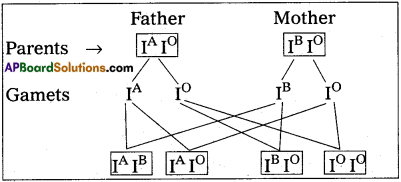
Genotypes of the off springs
IAIB – AB blood group
IAI° – A blood group
IBI° – B blood group
I°I° – O blood group
Question 7.
What is the genetic basis of blood types in ABO system in man?
Answer:
Three alleles of gene I are responsible for ABO blood grouping. They are IA, IB and I°.
IAIA / IAI° – for A blood group
IBIB / IB I° – for B blood group
IAIB – for AB blood group
I° I° – for O blood group
Question 8.
What is polygenic inheritance?
Answer:
Polygenic inheritance is a cumulative effect of two or more genes on a single phenotypic character. Eg: Skin colour in humans.
Question 9.
Compare the importance of Y-chromosome in human being and Drosophila.
Answer:
In human beings Y-chromosomes are responsible for the development of maleness.
In Drosophila Y-chromosome, lacks male determing factors, but contains only genetic information essential to male fertility.
Question 10.
Distinguish between heterogametic and homogametic sex determination systems.
Answer:
| Heterogametic | Homogametic |
| 1. It is the condition in which two types of gametes are formed. Eg: XY-in humans. |
1. It is the condition, in which similar type of gametes are formed. Eg: XX in females. |
| 2. They play a very important role in deciding the sex of the off spring | 2. It self, it can’t decide the sex of the progeny. |
Question 11.
What is haplo-diploidy?
Answer:
It is a mechanism of sex determination. In this system the sex of the offspring is determined by the number of sets of chromosomes. Eg : Honeybees.
In honeybees fertilised eggs developed into female and unfertilised eggs developed into male. This means male have half the number of chromosomes ie., haploid and the females have double the number i.e., diploid hence the name haplo.-diploidy.
Question 12.
What are barr bodies?
Answer:
Barr bodies are condensed heterochromatin in one of the ‘X’ chromosome found in the somatic cells of diploid females. These were observed by Murray. L.Barr in female cats and Moor? and Barr in female human beings.
![]()
Question 13.
What is Klinefelter’s syndrome?
Answer:
Klinefelter’s syndrome is caused by trisome in 23rd pair. A klinefelter’s male possesses an additional X chromosome along with the normal XY (i.e.,47 chromosomes).
Symptoms :
Hypogonadism, sterility, enlargement of breast, high pitched voice etc., Somatic cells of Klinefelter male exhibits barr bodies in their nuclei.
Question 14.
What is Turner’s syndrome?
Answer:
It is an allosomal disorder. The Karyotype is 45, it is due to monosomy in 23rd pair. These females have 42 autosomes and one X-chromosome.
Symptoms:
Short structure, gonadal dysgenesis, webbed neck, broad shield like chest and widely spaced nipples etc. Turners female does not show barr bodies.
Question 15.
What is Down syndrome?
Answer:
Down Syndrome is a genetic condition that causes delay in physical and intellectual development. The cause of this genetic disorder is the presence of an additional copy of the chromosome numbered 21.
Symptoms :
The affected individual is short, with small round head, furrowed tongue and partially open mouth. Physical and mental development is retarded.
Question 16.
What is Lyonisation?
Answer:
Lyonisation is a process by which one of two copies of X-ehromosome present in the body cells of female mammals is inactivated. The inactive X-chromosome is transcriptionally inactive called heterochromatic body.
Question 17.
What is sex-linked inheritance?
Answer:
The inheritance of a trait that is determined by a gene located on one of the sex chromosome is called sex linked inheritance.
Eg: Colour blindness, Haemophilia etc.
Question 18.
Define hemizygous condition?
Answer:
The condition in which thd genes are present on non-homologous portion of either X- chromosome (or) Y-chromosomes. For these genes, related alleles are absent on corresponding paired chromosomes.
Eg : X-linked genes and Y-linked genes in males.
Question 19.
What is crisscross inheritance?
Answer:
Crisscross inheritance is also called as skip generation inheritance. The X-linked recessive characters do not occur in one generation. They skip it off’in that generation and are expressed in the next generation. Eg: X-linked recessive characters – Colour blindness.
Colour blindness is transmitted from grandfather to his grandson through a carrier daughter.
![]()
Question 20.
Why are sex – linked recessive characters more in male human beings?
Answer:
Sex linked recessive characters are more in males because these genes located in the X-chromosome. Male possess only one X-chromosome and female possess two ‘X’ chromosomes. So male needs only one copy of the mutant allele to express the phenotype.
Question 21.
Why are sex – linked dominant characters more in female human beings?
Answer:
In sex-linked dominant inheritance, the gene responsible for genetic disorder is located on the X-chromosome, and only one copy of the allele is sufficient to cause the disorder. Females are more likely to be affected by sex-linked dominant characters as the females have 2X-chromosomes, they have double chance to inherit the character.
Question 22.
What are sex limited characters?
Answer:
The genes for sex limited characters are autosomal genes present in both males and- females. Their phenotypic expression is limited to only one sex due to internal hormonal. environment. Eg: Development of breast in women, beard in man.
Question 23.
What are sex influenced characters?
Answer:
The genes for sex influenced characters are autosomal genes present in both males and females. In sex influenced inheritance, the genes’ behave differently in the two sexes. Probably because sex hormones,provide different cellular environment in males and females. Thus heterozygous phenotype may exhibit one phenotype in males and the contrasing one in females. E.g.: Baldness in humans.
Question 24.
How many base pairs are observed in human genome? What is the average number of base pairs in a human gene?
Answer:
- 3164.7 million nucleotide base pairs were observed in a human genome.
- The average number of base pairs in human gene is 3000.
Question 25.
What is junk DNA?
Answer:
The entire DNAin the nucleus does not code for proteins. Some DNA codes for specific proteins and Some DNA involve in the regulation of expression of genes, codes for proteins. The remaining non-functional DNA is called junk DNA.
Question 26.
What are VNTRs?
Answer:
These are repetitive DNA composed of a number of copies of short sequence. The VNTR of two persons generally shows variations, they differ in the number of tandem repeats or the sequence of bases. They are useful as genetic markers.
![]()
Question 27.
List out any two applications.of DNA fingerprinting technology.
Answer:
- Medico-legal cases – Establishing paternity and (or) maternity more accurately.
- Forensic analysis – Positive identification of a suspect in a crime.
Short Answer Questions
Question 1.
Briefly mention the contribution of T.H. Morgan to genetics.
Answer:
1) T.H. Morgan worked on Drosophila melanogaster for experimental verification of the chromosomal theory of inheritance to discover the basis for the variatiori that sexual reproduction produced.
2) He also Carried out dihybrid crosses in Drosophila to study the independent inheritance of two pairs of characters. He formulated the chromosomal theory of linkage. He defined linkage as co-existence of two or more genes in the same chromosome. His experiments have also proved that tightly linked genes show very low recombination while loosely linked genes show higher recombination.
3) T.H. Morgan worked on Drosophila melanogaster to analyse the behaviour of the two alleles of a fruit fly’s eye – colour gene and he discovered sex lihked inheritance.
4) Morgan discovery that transmission of X-chromosome in Drosophila correlates with the inheritance of an eye colour trait was the first solid evidence indicating that a specific gene is associated with a specific chromosome.
Question 2.
What is pedigree analysis? Suggest how such an analysis, can be useful?
Answer:
Pedigree analysis is a record of inheritance of certain traits over two or more ancestral generations of a person in the form of a diagram of family tree.
Uses:
→ Pedigree analysis is useful to study the inheritance of a specific trait, abnormality or disease etc.,
→ It also helps to work out the possible genotypes from the knowledge of the respective phenotypes.
→ It is useful to study the pattern of inheritance of a dominant or a recessive trait.
→ The possible genetic make up of a person for a trait can also be known with the help of pedigree chart.
Genetic counselors use pedigree chart for analysis of various traits and diseases in family and predict their inheritance patterns. It is useful in preventing hemophilia, sickle cell anemia and other genetic disorders in the future generations.
Question 3.
How is sex determined in human beings?
Answer:
The sex determination in humans is XX-XY type. In human beings both females and males have same number of chromosomes i.e., 23 pairs. Out of 23 pairs, 22 pairs are exactly same in males and females. These are called autosomes. In addition to these (autosomes) female possesses two ‘X’ chromosomes while male possess one ‘X’ and one ‘Y’ chromosome. During spermatogenesis among males, two types of gametes are produced. 50% of the total sperm produced carry the X-chromosome and the rest 50% has Y-chromosomes besides the autosomes. Females however, produce only one type of ovum with an X’ chromosome.
There is equal probability of fertilisation of ovum with sperm carrying either X or Y chromosome. In case the ovum is fertilised with sperm carrying X-chromosome, the zygote develops into a female and the fertilisation of ovum with Y-chromosome carrying sperm results into male offspring. Thus, the sex of the child depends on the type of sperm involved in the fertilisation.
Question 4.
Describe erythroblastosis foetalis.
Answer:
Erythroblastosis foetalis develops in an Rh positive foetus, whose father is Rh positive and mother is Rh negative. In Rh positive person rhesus antigens are present on the surface of blood cells where as in Rh negative person Rhesus antigens are absent.
During the process of delivery, the foetal blood cells may pass through the ruptured placenta into the Rh negative maternal blood. The mother’s, immune system recognises the Rh antigens and gets sensitized and produces Rh antibodies. These antibodies are Ig G type they can pass through placenta. Generally first child is not effected because child is delivered by the time of the mother gets sensitized and produce antibodies.
During second pregnancy, if the second child is Rh positive, these antibodies cross the placenta, enter the foetal blood circulation and destroy the Rh positive blood cell of foetus (haemolysis), leads to haemolytic anemia and jaundice. To compensate the haemolysis of blood cells there is a.rapid production of RBC’s from the bone marrow, and but also from liver and spleen. Now many large and immature blood cells in erythrobtast stage are released into circulation. Because of this disease is called erythroblastosis foetalis.
![]()
Question 5.
Mention any two autosomal genetic disorders with their symptoms.
Answer:
1) Sickle-cell anaemia :
It is an autosomal recessive genetic disorder, characterised * by rigid, sickle-shaped red blood cells in hypoxia conditions.
Sickle cell anaemia is due to point mutation in the DNA that codes for p – globin polypeptide chain of haemoglobin molecule, causing the replacement of the glutamic acid in the sixth position by valine.
Symptoms:
The sickled erythrocytes are fragile and their continuous breakdown leads to anaemia called sickle-cell anaemia.
The sickled cells block the capillaries resulting in poor blood supply to tissue. This leads to physical weakness, pain, organ danjage and even paralysis.
2) Phenylketonuria :
It is an autosomal recessive, metabolic genetic disorder caused by a mutation in a gene code for phenylalanine hydroxylase, located in chromosome 12 The affected individual lacks the phenylalanine hydroxylase enzyme, that converts the aminoacid phenylalanine into tyrosine, results in accumulation of phenylalanine in tissues later it is converted to phenylpyruvate and their derivatives. All these metabolities are excreted in urine.
Symptoms :
Accumulation of these substances in the brain causes mental retardation, failure to walk or talk, failure of growth etc.
Question 6.
Describe the genetic basis of ABO blood grouping.
Answer:
Bernstein proposed the genetic basis of ABO blood grouping. The genetic basis of ABO blood grouping is mainly dependent on the three alleles IA, IB and I° of the gene I, located in chromosome 9. The alleles IA and IB are responsible for the production of the respective antigens A and B on the surface of RBC. The allele I° does not produce any antigen on the surface of RBC. The alleles IA and IB are dominant to the allele lp, but codominant to each other (IA = IB >I°).
A child receives one of the three alleles from each parent, giving rise to six possible genotypes and four possible blood types. The genotypes are IAIA, IAI°, IBIB, IBI°, IAIB, I°I°.
The phenotypic expression of IAIA and IAI° are A-type blood,
The phenotypic expression of IBIB and IBI° are B-type blood, and that of IAIB is AB blood type. The phenotype I°I° is ‘O’ – type blood.
Question 7.
Describe male heterogamety.
Answer:
In this mechanism, the female sex has two ‘X’ chromosomes, while the male sex has only a single X chromosome. The heterogametic .male may be of the following two.types.
1) XX – XO type :
In certain insects belonging to orders Hemiptera (true bugs), Orthoptera (grass hoppers) and Dictyoptera (cockroaches), female has two X chromosomes (XX) and are, thus homogametic, while male has only single X’ chromosome (XO). The male being heterogametic sex produces two types of sperms, half with X chromosome and half without X chromosome in equal proportions. The sex of the offspring depends upon the sperm that fertilises the egg, each of which carries a single X chromosome.
Thus fertilisation between male and female gametes always produced zygotes with one X Chromosome from the female, but only 50% of the zygotes have an additional X Chromosome from the male. In this way, XO’ and ‘XX’ types would be formed in equal proportions, the former being males and the latter being females.
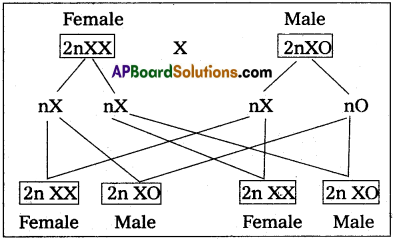
2) XX – XY type :
In man, other mammals, certain insects including Drosophila, the females possess two X chromosomes (XX) and are thus homogametic, produce one kind of eggs, each one with one X chromosome. While the males possess one X and one Y chromosome (XY) and are hence, heterogametic. They produce two kinds of sperms, half with X chromosome and half with Y chromosome. The sex of embryo depends on the kind of sperm. An egg fertilised by a X bearing sperm, produces a female, but if fertilised by a Y- bearing sperm, a male is produced.

Question 8.
Describe female hetergamety.
Answer:
In this method of sex determination the male produces similar type of gametes, while female produces dissimilar gametes. The heterogametic females may be of following two types.
i) ZO – ZZ :
This mechanism is found in certain moths and butterflies. In this case, female possesses one single ‘Z’ chromosome and hence is heterogametic, producing two kinds of eggs half with Z chromosome and another half without any Z chromosome. Male possesses two Z chromosomes and thus homogametic, producing single type of sperms, each carries single Z chromosome. The sex of the offspring depends on the kind of egg.

ii) ZW – ZZ:
This system is found in certain insects (gypsy moth) and vertebrates such as fishes, reptiles and birds. In this system, the female is heterogametic and produces two types of gametes, one with ‘Z’ chromosome and the other with ‘W chromosome. On the other hand, male is homogametic and produces all sperms of same type carrying one ‘Z’ chromosome. The sex of the offspring depends on the kind of egg being fertilised. The ‘Z’ chromosome bearing eggs produce males, but the W chromosome bearing eggs produces females.

![]()
Question 9.
Describe the Genic Balance Theory of sex determination.
Answer:
Genic balance mechanism of determination of sex was first observed and studied by C B.Bridges in 1921 in Drosophila. According to this mechanism, the sex of an individual in Drosophila melanogaster is determined by a balance between the genes for femaleness located in the X-chromosome and those for maleness located in autosomes. Hence, the sex of an individual is determined by the ratio of number of its X chromosomes and that of its autosomal sets, the Y chromosome being unimportant.

Individuals with sex index of 0.5 develop into normal males and those with sex index of 1 into normal females. If the sex index is between 0.5 and 1, the resulting individuals is called inter sex. Such individuals are sterile. Some flies have sex index of > 1, such flies are called super females or metafemales. Super male flies have a sex index value of < 0.5 and are also weak, sterile and non-viable.
| Sex index = X/A | Phenotypes |
| 0.5 | Male |
| 1.0 | Female |
| Between 0.5 and 1 | Inter sex |
| Below 0.5 | Metamale |
| Above 1.0 | Metafemale |
Bridges drew, crossed a triploid females (3A + XXX) with normal diploid males (2A + XY). From such a cross he obtained normal diploid females, males, triploid females, intersexes, metamales and metafemales.
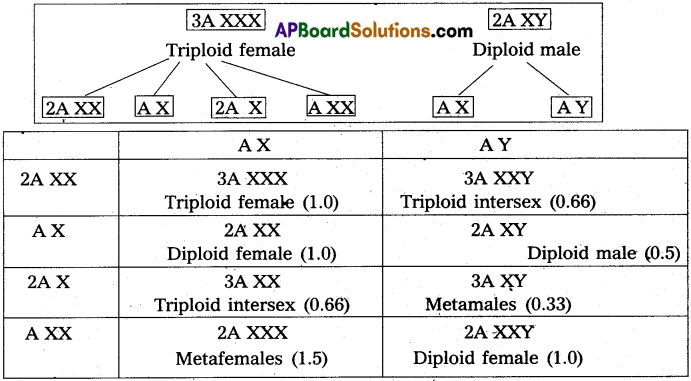
Question 10.
Explain in the inheritance of sex linked recessive character in human being.
Answer:
The sex linked recessive characters in human beings are : Colour blindness, Hemophilia etc.,
Colour Blindness :
Colour blindness if particular trait in human beings renders them unable to differentiate between the red colour and green colour. The gene for this colour blindness is located on X-chromosome. Colour blindness is recessive to normal vision so that if colour blind man marries a normal (homozygous) vision woman, all the sons and daughters are normal but daughters are heterozygous, which means that these daughters would be carriers to this trait. If such a carrier woman marries a man with normal vision, all the daughters and half of the sons have normal vision and half of sons are colour blind.

If carrier married to normal male
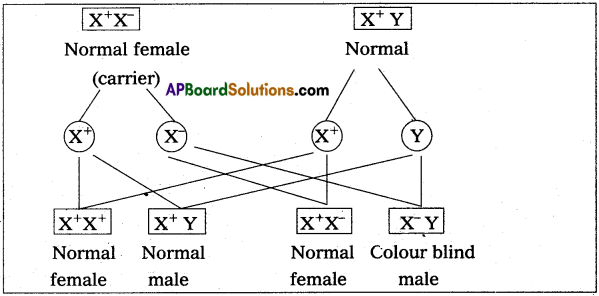
Hemophilia :
Hemophilia is the most notorious disease which is more common in men than women. This is also known as bleeder’s disease. It is the recessive character and is, therefore, masked in the heterozygous condition. Individuals suffering with this disease lack a factor responsible for clotting of blood. Consequently even a minor cut on the or in body surface may cause prolonged bleeding leading to death. Since it is caused by recessive X-lined gene, a lady may carry the disease and would transmit it to 50% of her sons, even if the father is normal.
Question 11.
Describe the experiment conducted by Morgan to explain sex linkage.
Answer:
Morgan worked on Drosophila melanogaster to analyse the behaviour of the two alleles of a fruitfly eye colour gene. From this work he discovered sex linkage.
Morgan’s experiment: When he crossed a white eyed (mutant) male to a normal (wild) red eyed female, in the F1 generation all the males and females were red eyed.
When F1 generation red eyed female was crossed to a red eyed male, in the F2 generation all the females and 50% of males were red eyed and remaining 50% males were white eyed. This type of inheritance of a character from grand father to grand son is called criss cross inheritance.
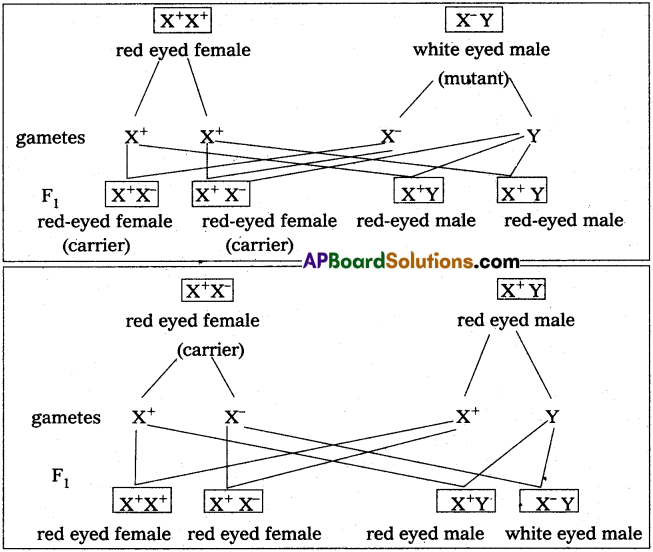
In reciprocal cross, in which a white eyed female was crossed to a red eyed male, the F1 resultant male offsprings had white eyes while the female offspring had red eyed. This proves that the allele responsible for the white eye is sex linked and recessive.

Question 12.
Explain the inheritance of sex influenced characters in human beings. ~
Answer:
Sex influenced genes are the autosomal genes, present in both males and females. In sex influenced inheritance, the genes behave differently in the two sexes, because the sex hormones provide different cellular environment in males and females Eg .’Baldness in humans.
The allele for baldness behave dominant (B) in males but recessive (b) in females. Pattern of baldness in man
| Genotype | Male | Female |
| BB | Baldness | Baldness (less affect) |
| Bb | Baldness | Non-bald |
| bb | Non-bald | Non-bald |
If a heterozygous non-bald woman (Bb) married a heterozygous bald man (Bb), in the offspring the ratio of bald to non bald ill the male progeny is 3:1 while in females it is 1:3.

Question 13.
A man and woman of normal vision have one son and one daughter. Son is colour blind and his son is with normal vision. Daughter is with normal vision, but one of her sons is colour blind and the other is normal. What are the genotypes of the father, mother, son and daughter?
Answer:
Man and woman of normal vision having colour blind son and normal vision daughter. So the genotype of women is carrier i.e., “X+X–” and man is normal i.e., “X+Y”.

In the above cross colour blind son marries a normal woman his son will be normal.

Daughter with normal vision are of her son is colour blind means she must be carrier i.e., X+X–“.
From the above reasons the genotype, of
Father is – X+Y Normal
Mother is – X+X– Normal (carrier)
Son is – X–Y Colour blind
Daughter is – X+X– Normal (carrier)
Question 14.
A colour blind man married a woman who is the daughter of a colour blind father and mother homozygous normal vision. What is the probability of their daughters being colour blind?
Answer:
A colourblind man married a woman, who is daughter of a colourblind father and mother homozygous normal vision that means the woman is carrier i.e., the genotype is ‘X+X–‘.
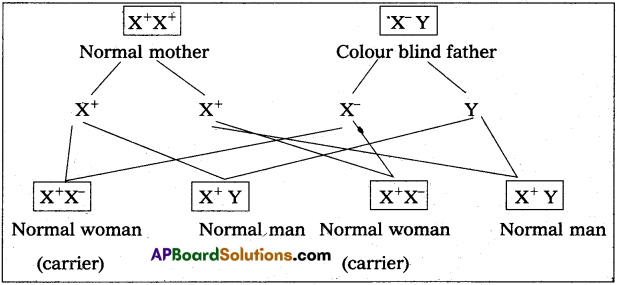
Here all women (daughters) are carriers, i.e., X+X–
A cross between colour blin$ man a woman from the above result
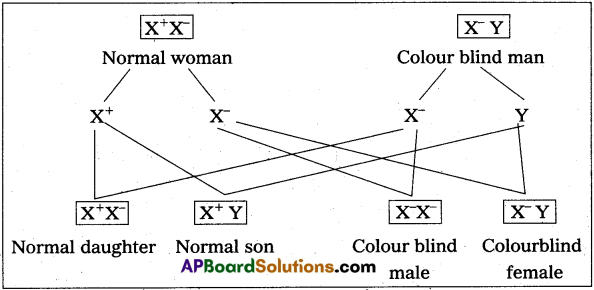
From the above cross the probability of their daughter being colour blind is 50% or 1/2 among the daughters or 1/4 among their child’s
Question 15.
A heterozygous bald man who is non-haemophilic, married a woman who is homozygous for the non-bald trait and is haemophilic. What is the probability of her male children become bald and haemophilic?
Answer:
Man is heterozygous bald and non-haemophilic = Bb X+Y
Woman is homozygous non-bald and haemophilic = bb X–X–
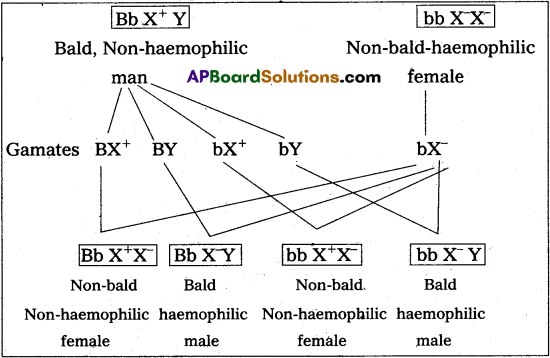
Thus the probability of bald and haemophilic male is 1/2 i.e, 50% among males produced.
Question 16.
A woman’s father shows ‘IF but her mother and husband are normally pigmented. What will be the phenotypic ratio of her children?
Answer:
In continentia pigment is an uncommon disorder, inherited on an X-Iinked dominant manner. In this condition, a random loss of melanin from skin leads to mosaic appearance of skin. It is occur much more often in females than in males.
A woman’s father shows IP but her mother is normally pigmented, that means the woman also shows IP.

Cross between women with IP and normal male (husbend)
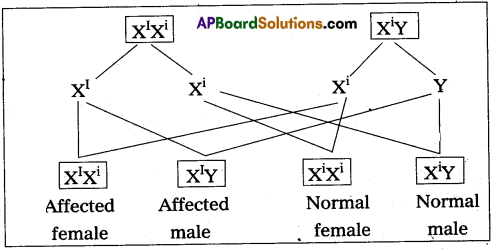
The phenotypic of children is 1 : 1
Question 17.
Write the salient of features of HGP.
Answer:
Salient features of HGP:
- The human genome comprised of 3164.7 million nucleotide bases.
- Human genome contains 30,000 genes.
- Each gene consist of ah average 3000 bases. ‘
- Functions of 50% of genes discovered are unknown.
- All proteins are coded by less than 2% of the genome.
- Majority of the genome consisted by repeated sequences.
- Chromosome one has highest number of genes i.e., 2,968 genes and Y chromosome has the fewest genes i.e., 231 genes.
- It is also identified that 1.4 millions locations, where Single base DNA difference (SNPs) occurs in humans. This information promises to revolutionise the process of finding chromosomal locations for disease associated sequences and tracing human history.
![]()
Question 18.
Describe the steps involved in DNA finger printing technology.
Answer:
DNA finger printing is a method for indentifying an individual by particular structure of their DNA.
Steps involved in DNA finger printing :
1. Obtaining DNA:
The DNA sample is collected from blood, Saliva, hair root, semen etc.,
2. Fragmentating DNA:
The DNA is treated with restriction enzymes to cut DNA at specific sites and form smaller fragments, .
3. Separation of DNA fragments:
The DNA fragments are separated by electrophoresis based on their charge and molecular weight.
4. Denaturaling of DNA:
The DNA on the gel is denatured by using alkaline chemicals.
5. Blotting :
Through a blotting technique the DNA fragments on the gel is transferred to nylon membrane. •
6. Using probes to identify specific DNA :
A radioactive probe is added to the DNA bands, which is complementary to the DNA bands, which is complementary to those of interested gene fragment.
7. Hybridization with probe :
After the probe hybridizes, excess probe washed off by washing. A photographic film is placed on the membrane containing DNA hybrids.
8. Exposure on film to make a DNA finger print:
The radio active label exposes the film to form bands corresponding to specific DNA bands.
Those bands form a pattern of bare which constitute a DNA finger print.
Long Answer Questions
Question 1.
What are multiple alleles? Describe multiple alleles with the help of ABO blood groups in man.
Answer:
Generally a gene has two alternative forms called allele. Sometimes a gene may have more than two alleles. These are referred to as multiple alleles. When more than two alleles exist fn a population of a specific organism, the phenomenon is called multiple allelism. Multiple’alleles cannot be observed in the genotype of a diploid individual, but can be observed in a population.
The number of genotypes that can occur for multiple alleles is given by the expression where ‘n’ = number of alleles.
ABO blood groups are the best example for multiple allelism in human beings.
The ABO blood group system was proposed by Karl Landsteiner. The blood groups A, B, AB and O types are characterised by the presence or absence of antigens on the surface of RBC. Blood type ‘A’ person have antigen A on their RBCs and anti-B antibodies in the plasma. Blood type ‘B’ person have antigen B. On their RBCs and anti-A. antibodies in the plasma. Blood type ‘AB’ person have antigens A
| Blood group | Antigen on RBC | Antibodles in Plasma |
| A | A | b |
| B | B | a |
| AB | AB | — |
| O | — | A, b |
Bernstein discovered that these phenotypes were’inherited by the interaction of three autosomal allies’ of the gene named T, located on chromosome 9. IA, IB and I° are the three alleles of the gene I. The alleles IA and IB are responsible for the production of the respective antigens A and B. The allele I° does not produce any antigen. The alleles IA and IB are dominant to the allele I° but co-dominant to each other (IA = IB > I°).
A child receives one of the three alleles from each parent, giving rise to six possible genotypes and four possible blood types. The genotypes are IAIA, IAI°, IBIB, IBI°, IAIB, I° I°. The phenotypic expressions of IA IA and IA I°, are A-type blood, the phenotypic expression of IB IB and IBI° are B-type blood, and that of IA IB, is AB blood type. The phenotype I° I° (ii) is ’O-type’ blood.
Question 2.
Describe chromosomal theory of sex determination.
Answer:
Chromosomal sex determination :
The chromosomes, which’ determine the somatic characters of an individual are known as autosomes. These chromosomes do not differ in morphology and number in male and female sex. Those chromosomes, which differ in morphology and number in male and female sex and contain genes responsible for the determination of sex are known as allosomes or sex chromosomes. There are two types of sex chromosomal mechanisms :
a) Heterogametic male and
b) Heterogametic female
a) Heterogametic male :
In this mechanism, the female sex has two ‘X’ chromosomes, While the male sex has only a single X chromosome.
The heterogametic male may be of the following two types :
(i) XX – XO (ii) XX – XY
i) XX – XO type :
In certain insects belonging to orders Hemiptera (true bugs), Orthoptera (grass hoppers) andDictyoptera (cockroaches) female has two X” chromosomes (XX) and are, thus homogametic, while male has only siftgle X” chromosome (XO). The, male being heterogametic sex produces two types of spgrms, half with X chromosome and . half without X chromosome in equal proportions. The sex of the offspring depends upon the sperm that fertilises the egg, each of which carries a singfe X chromosome. Thus fertilisation between male and female gametes always produced zygotes with oiie X chromosome from the female, but only 50% of the zygotes have an additional X Chromosome from the male. In this way, XO’ and ‘XX’ types Would be formed in equal proportions, the former being males and the latter being females.

ii) XX – XY type :
In man, other mammals, certain, insects including Drosphila, the females possess two X chromosomes (XX) and are thus homogametic, produce one kind of eggs, each one with one X chromosome. While the males possess one X and one Y chrbmosoihe (XY) and are hence, heterogametic. They produce two kinds of sperms, half with X chromosome and half with Y chromosome. The sex of embryo depends on the kind of sperm. An egg fertilised by a X bearing sperm, produces a female, but if fertilised by a Y bearing sperm, a male is produced.

b) Heterogametic female :
In this method of sex determination, the maid produces similar type of gametes, while female produce dissimilar gametes. The heterogametic fehiales may be of following two types, (i) ZO – ZZ (ii) ZW – ZZ.
i) ZO – ZZ :
This mechanism is found in certain moths and butterflies. In this case, female possesses one single ‘Z’ chromosome and hence is heterogametic, producing two kinds of eggs half witji Z chromosome and another half without any Z chromosome. Male possesses two Z chromosomes and thus homogametic, producing single type of sperms, each carries single Z chromosome. The sex of the offspring depends on the kind of egg.
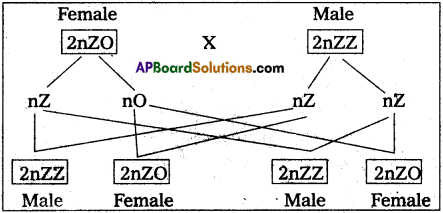
ii) ZW – ZZ:
This system is found in certain insects (gypsy moth) and vertebrates such as fishes, reptiles and birds. In this system, the female is heterogametic and pi duces two types of gametes, onfe with ‘Z’ chromosome and the other with W chromosome. On the other hand, male is homogametic and produces all sperms of same type carrying one ‘Z’ chromosome. The sex of the offspring depends on the kind of egg being fertilised. The ‘Z’ chromosome bearing eggs produce males, but the W chromosome bearing eggs produces females.
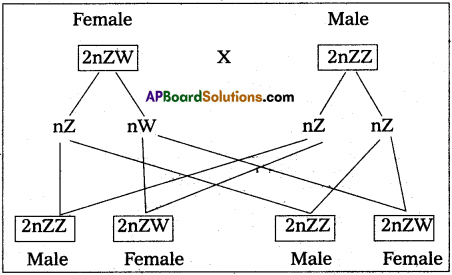
Question 3.
What is crisscross inheritance ? Explain the inheritance of one sex linked recessive characters in human beings.
Answer:
The X-linked genes are represented twice in female (because female has two ‘X’- chromosomes) and once in males, (because male has one X-chromosome). In male single. X-linked recessive gene express it phenotypically, in contrast to female in which two ‘X’ linked recessive genes are necessary for the determination of a single phenotypic trait related to sex.
The recessive X-linked genes have chracteristic crisscrossinheritance.
Crisscross inheritance :
The inheritance of X-linked recessive trait (genes) to his grandson (F2) through his daughter (carrier) is called crisscross inheritance. Crisscross inheritance can be explained in humans by sex-linked recessive disorder, colour blindness.
Colourblindness :
Colour blindness is a particular trait in human beings render them unable to .differentiate between red and green colour. The gene for this colour blindness is- located on X-chromosome. Colour blindness is recessive to normal vision so that if colour blind man marries a normal vision (homozygous) woman, all the sons and daughters are normal but daughter are heterozygous, which means that these daughters would be carrier for this trait. If such carrier woman marries a man with normal vision all the. daughters and half of the sons have normal vision and half of sons are colour blind.
Colour blind trait is inhereted from a male parent to his grandson through carrier daughter i.e., this trait shows crisscross inheritance
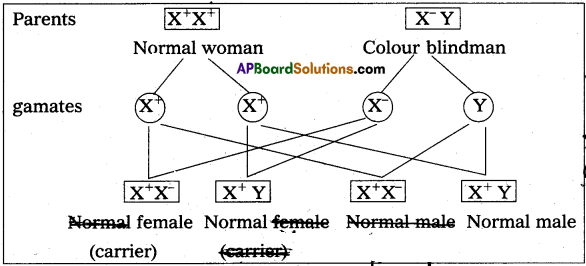
If carrier female is married to normal male
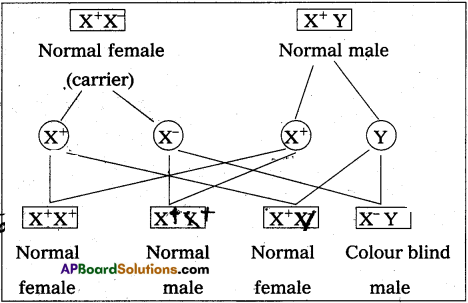
Characteristics of X-linked recessive traits :
- They never passed from father to son.
- Males are much more likely to be affected because they need only one copy of the mutant allele to express the phenotype.
- Affected males get the disease from their carrier mother only.
- Sons of heterozygous female (i.e., carrier female) have 50% chance of receiving mutant alleles. These disorders are typically passed from an affected grandfather to 50% of his grandsons.
- The X-linked recessive traits shows Crisscross pattern of inhertance.
Eg : Colourblindness, Hemophilia, Muscular dystrophy etc.,
![]()
Question 4.
Write an essay on common genetic disorders.
Answer:
A number of disorders in human beings have been found to be associated with the inheritance of changed or altered genes of chromosomes.
Genetic disorders broadly grouped into two categories :
(1) Mendalian disorders, (2) Chromosomal disorders
1) Mendelian disorders :
These are genetic disorders showing Mendelian pattern of inheritance, caused by a single mutation in structure of DNA.
Most common and prevalent Mendelian disorders are: Haemophilia, Cystic fibrosis, sickle cell anaemia, colour blindness, phenyl ketonuria, thalassemia etc.,
I. Haemophilia : It is also called as bleeder’s disease.
(a) Haemophilia-A:
This is sex linked recessive disorder, transmitted by females and affecting males. Haemophilia-A is the rhost common clotting abnormality and is due to the deficiency of clotting factor VIII.
Symptoms :
The affected individuals have prolonged clotting time and suffer from internal bleeding. .
(b) Haemophilia-B :
This is due to the deficiency of clotting factor IX.
symptoms :
Symptoms are similar to that found in haemophilia-A.
II. Sickle-cell anaemia :
It is an autosomal recessive genetic disorder, characterised by rigid, sickle-shaped red blood cells in hypoxia condition. It is due to point mutation in the P-globin gene causing replacement of glutamic acid in the sixth position by valine.
Symptoms :
Haemolysis leads to sickle-cell anaemia sickle cells block. The capillaries resulting in poor blood supply to tissue leads to’ physical weakness, pain, organdamage, paralysis etc.,
III. Phenylketonuria:
This is an autosomal recessive metabolic genetic disorder caused by a mutation in the gene codes for phenylalanine hydroxylase. This enzyme catalyses the convertion of phenylalanine into tyrosine. Defect of this enzyme leads to accumulation of phenylalanine derivatives like pheriylpyruvate, phenylacetate etc.,
Symptoms :
Mental retardation, failure to walk or talk, failure of growth etc.,
IV. Colour blindness :
It is a sex linked disorder. It is the inability to differentiate between some colours. This phenotypic trait is dumb mutation in certain genes located in X-chromosome.
Symptoms : Protanopia – red colour blindness
Deuteranopia – green colour blindness
Tritanopia – blue colour blindness
V. Thalassemia :
Thalassemia is an autosome linked recessive blood disorder. Thalassemias are characterised by a defect in the a or 13 Globin chain, resulting in production of abnormal haemoglobin molecules leads to anaemia.
Symptoms : Anaemia .
VI. Cystic fibrosis :
It is an autosomal recessive genetic disorder. It is the result of mutation in the gene that influences salt and water movement across epithelial cell membrane.
Symptoms :
The mucus builds up in organs such as lungs, pancreas, GI tracts etc., If they are not treated it may lead to death.
2. Chromosomal disorders:
Chromosomal disorders are caused by errors in the number or structure of chromosomes.
Allosomal disorders :
I. Klinefelter’s syndrome :
This genetic disorder due to the presence of additional X-‘ chromosome along with the normal XY.
Symptoms : The resulting young sterile male shows feeble breast, small testicles, rounded hips etc., .
II. Turner’s syndrome:
A female with 44 autosomes with one X-chromosome, such females are sterile.
Symptoms : Short structure, webbed neck, broad shield chest with widely spaced nipples, poorly developed ovaries etc.,
Autosomal disorders :
I. Down syndrome (Trisomy 21):
The cause of this genetic disorder is the presence of an additional copy of chromosome numbered 21.
Symptoms : Small rounded head, furrowed tongue and partially open mouth mental retardent etc., –
II. Edwards syndrome (Trisomy 18):
This is due to presence of an extra copy of genetic material on the 18th chromosome, either in whole or a part.
Symptoms : Majority of people with the syndrome die during the foetal stage due to defect in heart and kidney. .
III. Patau syndrome (Trisomy 13):
Patau syndrome is due to presence of an addition copy of chromosome number 13.
Symptoms : Kidney and heart defects, intellectual disability etc.,
Question 5.
Why is the human genome project c,ailed a mega project?
Answer:
Human genome project was an international effort formally begun in October, 1990. The HGP was a 13-year project coordinated by the U.S. Department of Energy and National Institute of Health. During early years of the HGP, the Wellcome trust became major partner and additional contributions came from Japan, France, Germany, China and others.
The total expenditure of this project is 3 billion dollars. This proeject almost completed in 2003.
Goals of HGP:
- Identify all the genes (20,000-25,000) in human DNA.
- Determine the sequence of entire human DNA.
- Improve tools for data analysis.
- Address the ethical, legal and social issues that may arise from the project.
Genome sequencing:
DNA sequencing is the process of determine the exact order of the 3 billion paired chemical building blocks that make up the DNA of the 22 autosomes X and Y chromosomes.
→ For sequencing the total DNA from a cell is isolated and converted into random fragments of relatively smaller size by using restriction enzymes and cloned in suitable most using specialised vectors.
→ The cloning results in the amplification of DNA fragments which are used for sequencing the bases.
→ Bacteria, yeast are most commonly used hosts and vectors are called ‘BAG’ and YAC’.
→ The fragments were sequenced using automated DNA sequencers that worked based on the principle of Sangers dideoxy method.
→ To allign these sequence a specialised computer based programs were developed, because it is humanly not possible.
→ These sequences were subsequently annotated and were assigned to each chromosome.
Salient features of human genome :
The human genome comprised of 3164.7 million nucleotide bases.
- Human genome contains 30,000 genes.
- Each gene consist of an average 30,000 bases.
- Functions are unknown for over 50% of the genes discovered.
- Lessthan 2% (nearly 1.5%) of the genome codes for proteins.
- Majority of the genome consisted of repeated sequences.
- Chromosome one has the highest number of genes i.e., 2,968 genes*and Y- chromosome has the fewest genes i.e., (231) genes.
- It is also identified that 1.4 million locations where single base DNA differences (SNPs) occur in humans. This information promises to revolutionise the process of finding chromosomal locations for disease associated sequences and tracing human history.
Advantages of HGP:
- Identification and mapping of the genes responsible for diseases helps in diagnosis, treatement and prevention of these diseases.
- It is useful to know the gene expression of different species, cellular growth, differentiation and evolutionary biology.
- To improve gene therapy for genetic disorders.
Becuase on the above views the human genome project was called a mega project.
![]()
Question 6.
What is DNA finger printing ? Mention its applications.
Answer:
DNA finger printing is a method for identifying individuals by the particular structure of their DNA.
Human DNA consists of 3 billion nucleoticdes, 90% Of which are identical among all individuals. No two people have exactly the same sequence of base in their DNA. Restricion fragment length polymorphism are characteristic to every person’s DNA. They are called Variable Number Tandem Repeats (VNTRs) and are useful as “Genetic markers”. The VNTRs of two persons generally show variations. DNA finger printing involves in dentifying differences in some specific regions in DNA sequence called repetitive DNA. These sequences show high degree of polymorphism and*form the basis of DNA finger printing.
Protocol of DNA finger printing :
1. Obtaining DNA:
DNA sample is collected from the blood, saliva, hair roots, semen etc. If needed many copies of the DNA is amplified by using PCR.
2. Fragmenting DNA (or) Restriction Digestion :
DNA sample is treated with restriction enzymes to cut the DNA at a specific sites and form smaller fragments.
3. Separation of DNA fragments by electrophoresis :
By using agarose gel electrophresis the DNA fragments are separated based on their charge and molecular weight.
4. Denaturing DNA:
The. DNA on the gel is denatured to form single stranded DNA strands using alkaline chemicals.
5. Blotting :
A thin’nylon membrane is placed over the size fractioned DNA strands and covered by paper towels. As the towels draw moisture the DNA strands are transferred on to-the nylon membrane by capillary action. This process is called blotting.
6. Using probes to identify specific DNA:
A radio active probe is added to the DNA bands. The probe is a single stranded DNA molecule that is complementary to the gene of interest in the sample under study. The probe attaches by base pairing to those restriction fragments that are complementary to its sequence.
7. Hybridization with probe :
After the probe hybridizes, the excess probe is washed off by washing. A photographic film is placed on the membrane containing DNA hybrids.
8. Exposure on film to make a DNA finger print:
The radioactive label exposes the film to form an image in the form of bands corresponding to specific DNA bands. These bands form a pattern of bars which constitute a DNA finger print.
Applications of DNA finger printing :
- Conservation of wild life : Protection of endangered species, by maintaining their records for identification of tissues of the dead endangered organisms.
- Taxonomical applications : Study of Phytogeny.
- Pedigree analysis : Inheritance pattern of gene through generations.
- Anthropological studies : Charting of origiij and migration of human population.
- Medico-legal cases : Establishing paternity and or maternity more accurately.
- Forensic analysis : Positive identification of a suspect in a crime.
The Process of DNA finger printing :
1. The process begins with a blood or cell sample from which the DNA is extracted.

2. The DNA is out into fragments using a restriction enzyme. The fragments are then separated into bands by electrophoresis through an agarose gel.
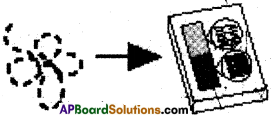
3. The DNA band pattern is transferred to a nylon membrane.

4. A radio active DNA probe is introduced. The DNA probe binds to specific DNA sequences on the nylon membrane.

5. The excess probe material is washed away leaving the unique DNA band pattern.

6. The radioactive DNA pattern is transferred to X-ray film by direct exposure. When developed, the resultant visble pattern is the DNA finger print.
